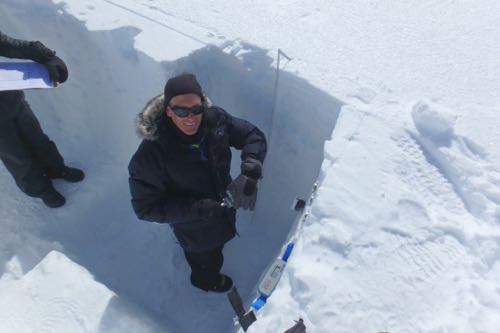We headed back out to the drill site this morning to conduct some scientific tests in the 2 meter deep pit that we dug yesterday. The samples we took out of the pit will be analyzed once they get back to Dartmouth College. But, we decided to do some field tests today. One of the science technicians, Heather McIntyre, showed us how to do these.
The area we were looking at was 1.7 meters deep. The first experiment we did was to measure the temperature of the firn all the way down. We took temperature reading every 3 centimeters for a total of 57 readings. We found that at the surface, the temperature was -11 degrees celsius. By the time we got down to 1.7 meters, the temperature of the firn was -28 degrees Celsius. This was expected and this temperature gradient is the main factor that causes the firn to change this close to the surface.
 Science Technician Heather McIntyre demonstrates how to measure the temperature of the snow on the wall of a snow pit.
Science Technician Heather McIntyre demonstrates how to measure the temperature of the snow on the wall of a snow pit.
Next, we took small samples of the firn to determine its density. Once again, we took samples every 3 centimeters. This was a tedious task because you had to stick a small tool in and try to extract a full sized sample. Sometimes it worked the first time, but it often took several tries to get a valid sample. Once obtained, each sample was weighed so the density could be calculated. The results of these tests will be compared to the densities calculated using more advanced methods in the lab back at Dartmouth.
 Researcher Eric Wagner carefully obtains samples of snow for testing.
Researcher Eric Wagner carefully obtains samples of snow for testing.
 PolarTREC teacher Steve Kirsche is conducting density measurements on samples from the wall of a snow pit.
PolarTREC teacher Steve Kirsche is conducting density measurements on samples from the wall of a snow pit.
Later in the day, we decided to create a backlit snow pit. To do this, a second pit was dug next to the first one. A small column of snow, about 6 inches wide, was left between the two pits.
 Without the sun shining through it, this is what the snow pit wall looks like.
Without the sun shining through it, this is what the snow pit wall looks like.
The interesting aspect of a backlit pit is when you cover the pit away from the sun. You then go down into the darker pit and look at the 6 inch wall of snow that has the sun shining through it. When you do, you get something that looks like this:
 The thin layer of snow is lit up by the sun shining through it.
The thin layer of snow is lit up by the sun shining through it.
What you can see in the picture above are the layers of snow that have accumulated. There are thick layers that generally correspond to winter snow accumulations. The thinner layers indicate where the snow has been compacted, usually due to slight surface melting from the sun during the summer.
Once our backlit pit was completed, the team hosted about 10 residents out at the drilling camp. The drillers demonstrated their drill and showed how the drill worked. The rest of us showed everyone the backlit snow pit. It was great to share some of what we have been doing with the other Summit Station residents.


Comments
Add new comment